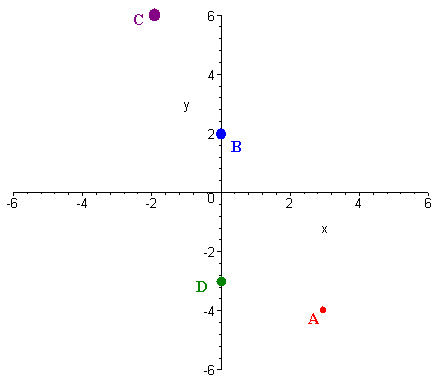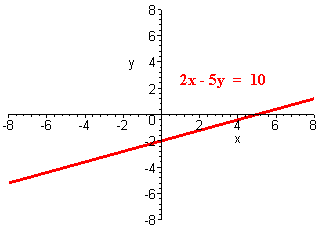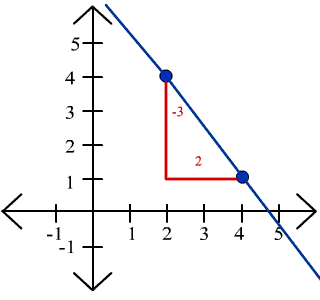Practice Exam 2
Please work out each of the given problems. Credit will be based on the steps that you show towards the final answer. Show your work.
Problem 1 Solve the following inequalities and sketch the solution set on a number line.
A. 3x - 5 > 2
Solution
3x - 5 > 2 add 5 to both sides
3x > 7 divide both sides by 3
x > 7/3
The graph is shown below.

B. 5 - 2x > 9
Solution
5 - 2x > 1 subtract 5 from both sides.
-2x > -4 divide by -2, changing the inequality sign for the negative.
x < 2
The graph is shown below.

C. -4 < 6 - 2x < 10
Solution
-10 < 6 - 2x < 10
-16 < -2x < 4 Subtract 6 from all three sides.
8 > x > -2 Divide all three by -2, changing the inequality sign for the negative.
The graph is shown below.
![]()
Problem 2
Depending on his mood, Chris drives between 60 miles per hour and 80 miles per hour on the freeway. Write a compound inequality that represents the range of time that it will take Chris to drive the 100 mile trip from here to Sacramento.
Solution
The time that it takes is the distance divided by the speed. The distance is 100 for both and the speed is between 60 and 80, hence
100/80 < t < 100/60
Problem 3
Find the rise and the run from the point P1 = (-3,6) to P2 = (-5,-8).
Solution
The rise is the change in y-values. To find this we subtract
rise = -8 - 6 = -14
The run is the change in x-values. To find this we subtract
run = -5 - (-3) = -5 + 3 = -2
Problem 4
Answer the following true or false and explain your reasoning.
A. The point (3,-4) is in Quadrant IV.
Solution
True, since Quadrant IV contains all the points with positive x-values and negative y-values.
B. If the point P is in Quadrant II and the rise and run from P to Q is 5 and 2, then Q is in Quadrant I.
Solution
False, for example if P = (-10,1) then Q = (-8,6) which is in Quadrant II.
Problem 5
Plot the following points.
A. (3,-4)
B. (0,2)
C. The point S, where S is the point such that the rise and run from S to (3,4) are -2 and 5.
D. Any point on the line 3x - 2y = 6.
Solution
They are shown below. For part C, to find S we take
3 - x = 5 Subtract 2 from both sides.
-x = 2 Multiply by -1
x = -2
and
4 - y = -2 Subtract 6 from both sides
-y = -6 Multiply by -1.
y = 6
So S is the point (-2,6).
We have chosen x = 0 for part D (any value of x will work as long as y is calculated correctly). Then
3(0) - 2y = 6
-2y = 6 Divide both sides by -2.
y = -3
This gives the point (0,-3).

Problem 6
Sketch the graphs of the following lines and find the x and y intercepts is they exist.
A. 2x - 5y = 10
Solution
We find set x = 0 and find y:
2(0) - 5y = 10
-5y = 10 Divide both sides by -5
y = -2
Next set y = 0 and find x
2x - 5(0) = 10
2x = 10
x = 5
This gives the table
| x | y |
| 0 | -2 |
| 5 | 0 |
The plot the points and connect with a line. The x-intercept is 5 and the y-intercept is -2. The graph is shown below.

B. y = 4
Solution
This is just the horizontal line four units above the x-axis. There is no x-intercept and the y-intercept is 4.

C. y + 2/3 x = 4
Solution
We can subtract the 2/3 x from both sides to get
y = -2/3 x + 4
which is a line with slope -2/3 and y-intercept 4. We can begin at the point (0,4), "rise" down 2 and "run" across 3. To find the x-intercept, set y = 0 and solve.
0 = -2/3 x + 4
0 = -2x + 12
2x = 12
x = 6
The x-intercept is 6.
The graph is shown below.

D. x = -3
Solution
This is the vertical line that crosses the x-axis at x = -3. The x-intercept is -3 and there is no y-intercept. The graph is shown below.

E. The line that passes through the point (2,4) and has slope -3/2.
Solution
We just sketch the point (2,4) then "rise" down 3 and "run" across 2. The graph is shown below.

To find the intercepts, first find the equations using the point-slope formula.
(y - 4) = -3/2(x - 2)
y - 4 = -3/2 x + 3
y = -3/2 x + 7
We see that the y-intercept is 7. For the x-intercept, set y = 0 and solve.
0 = -3/2 x + 7
0 = -3x + 14
3x = 14
x = 14/3
So the x-intercept is at x = 14/3.
Problem 7
A. Find the slope of the line that is parallel to the line that passes through the points (2,-3) and (5,6).
Solution
Parallel lines have the same slope, so we need only to find the slope through the points (2,-3) and (5,6).
The rise is:
6 - (-3) = 6 + 3 = 9
and the run is:
5 - 2 = 3
Hence the slope is
m = rise/run = 9/3 = 3
B. Find the slope of the line that is perpendicular to the line that passes through the points (0,2) and (2,3).
Solution
First, we find the slope of the line through the two points.
The rise is:
3 - 2 = 1
and the run is:
2 - 0 = 2
Hence the slope is
m = rise/run = 1/2
Our line is perpendicular, so we take the reciprocal of the this slope and multiply by (-1) to get
(-1) (2/1) = -2
Problem 8
Find the equation of the line in slope intercept form with the following properties.
A. Passes through the points (2,3) and (4,-1).
Solution
First we find the slope. The rise is
-1 - 3 = -4
and the run is
4 - 2 = 2
Hence the slope is
m = rise/run = -4/2 = -2
Now use the point slope formula with the point (2,3) and the slope -2 to get
y - 3 = (-2)(x - 2) = -2x + 4 Add 3 to both sides
y = -2x + 7
B. Passes through the point (-4,2) and has slope -2/5.
Solution
We use the point slope formula to get
y - 2 = (-2/5)(x - (-4)) =((-2/5)(x + 4) = -2/5 x - 8/5 Add 2 to both sides
y = -2/5 x - 8/5 + 2 = -2/5 x - 8/5 + 10/5 = -2/5 x + 2/5
or
y = -2/5 x + 2/5
Problem 9
The graphs of several lines are shown below. decide which of the statements are true and which are false and explain your reasoning.

A. The slope of line II is greater than the slope of line I.
Solution
False. The slope of line II is negative and the slope of line I is positive. Negative numbers are always smaller than positive numbers.
B. The y-intercept of lines I and II are equal.
Solution
True. They are both equal to 2.
C. The x-coordinate of the x-intercept of line I is greater than the x-coordinate of the x intercept of line III.
Solution
False. Line I has negative x-intercept and line III has negative x-intercept.
D. Lines I and II are perpendicular.
Solution
False. The slope of line I is 2/2 = 1 and the slope of line II is -2/1 = -2. Since their produce is
(1)(-2) = -2
which is not -1 they are not perpendicular.
Problem 10
Simplify the expressions below.
A.
p3y4
p2y
Solution
Use the quotient rule for exponents
p3y4
=
p3-2 y4-1 = p1 y3
= p y3
p2y
B. 51 - (xyz)0 + 30
Solution
We remember that anything to the 0 power is 1 and the first power leave the number the same. The expression becomes
5 - 1 + 1 = 4 + 1 = 5
Problem 11
Find
A. (x3yz - 3z3 + 2yz2 + x) + (2x3yz + 5z3 - 4x) - (2z3 - 5yz2 + x)
Solution
We first distribute the "-" through:
x3yz - 3z3 + 2yz2 + x + 2x3yz + 5z3 - 4x - 2z3 + 5yz2 - x
Now combine like terms.
x3yz - 3z3 + 2yz2 + x + 2x3yz + 5z3 - 4x - 2z3 + 5yz2 - x
= 3x3yz + 7yz2 - 4x
B. 5a2b(2ab2 - a3b + 3a7b5)
Solution
Distribute the 5a2b through
5a2b(2ab2) + 5a2b(-a3b) + 5a2b(3a7b5)
= 10a3b3 - 5a5b2 + 15a9b6
Problem 12 Find
A. (x3+2x2 - 3x - 6) ÷ (x + 2)
Solution
We divide using long division
x2 - 3
x + 2 | x3 +
2x2 - 3x - 6
x3 + 2x2
-3x - 6
-3x - 6
0
So the solution is
x2 - 3
B. (3x - 4)(7x + 2)
Solution
We FOIL
F = (3x)(7x) O = (3x)(2) I = (-4)(7x) L = (-4)(2)
So multiply and add
21x2 + 6x - 28x - 8
21x2 - 22x - 8
C. (x2 + 2x)(3x3 - 4x + 5)
Solution
We multiply the x2 by each of the three terms and the 2x by each of the three terms(x2)(3x3 - 4x + 5) + (2x)(3x3 - 4x + 5)
= 3x5 - 4x3 + 5x2 + 6x4 - 8x2 + 10x
= 3x5 + 6x4 - 4x3 - 3x2 + 10x
e-mail Questions and Suggestions